Long before Wolf Grey became all the rage, there was something else. In the early 1990s Army Special Operations Command experimented with a layered clothing system called Battle Dress System. Leveraging lessons learned from the original Extreme Cold Weather Clothing System (ECWCS), it featured a Capilene Next to Skin layer, Fleece mid-layers including a bib and pile jacket, a Gore-Tex undergarment and an outer layer called the SOF BDU. The underlayers were all Black and eventually became the Lightweight Environmental Protection (LEP) component of SPEAR. In all, BDS consisted of six layers with an additional NBC layer that was never developed.
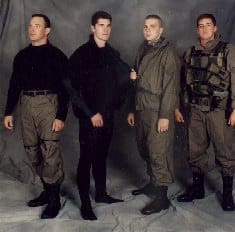
Developed as a Tech Base project, the goal was quite ambitious. BDS was touted as offering “protection against weather extremes, ballistic threats, chemical and biological threats, and enemy detection. The uniform is intended solely for combat. It will be multi-layered and will be adaptable to different weather conditions. The uniform will have integrated detection avoidance technologies as well as a chemical and biological agent protective layer. The rest of the system will additionally provide the user with a load-bearing system that adapts to the mission at hand as well as attachable/detachable body armor components.”
The system itself was quite popular with those that used it, offering material and design improvements over ECWCS which was just beginning to see widespread fielding.
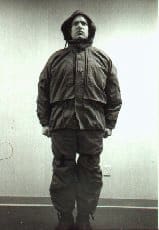
The SOF BDU consisted of a smock-like combat jacket and field trouser in a hue called Mouse Grey. These were essentially over garments that were intended to be worn as an outerlayer, over any combination of the other components depending on the weather. The material was new and consisted of Nylon, Cotton and Kevlar for increased abrasion resistance.
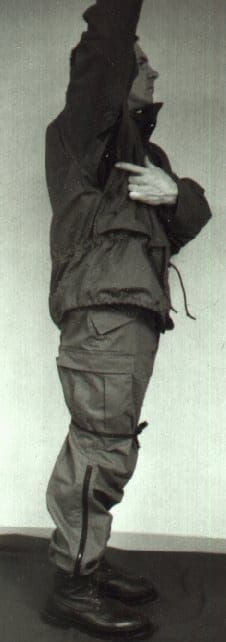
The design of the jacket was unlike anything else in the inventory with large Napoleon pockets on the chest and a hood that could be stored in the collar. It also boasted pit zips for ventilation, a rank tab on the chest and pockets mounted on the sleeves. The pants were quite similar to the M1950 field trouser and incorporated thigh tapes designed to help stabilize the load in the cargo pockets. They also added a zippered lower leg opening in order facilitate donning and doffing. There was also a Boonie hat as part of the system.
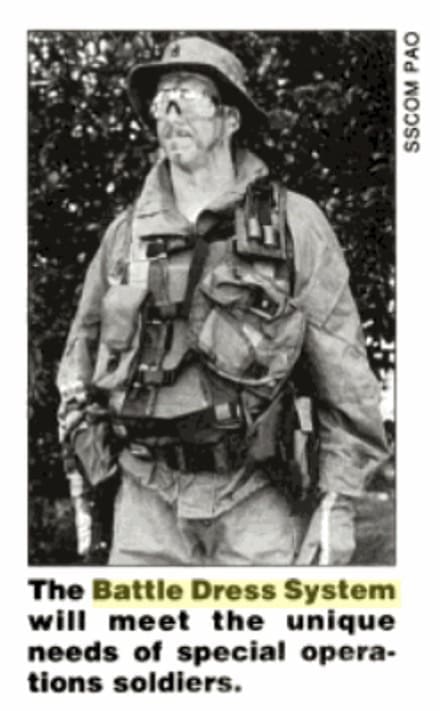
It was trialled along with a laid carriage and armor suite crafted by JS Industries called the Predator System. JS Industries eventually morphed into Paraclete Industries and Predator was a modular system which used system similar to PALS.
The Predator system was made from a greenish mesh and a Grey-Green Cordura which didn’t quite match the clothing. The Soft Snap attachment is an integral part of the pouch. It consists of 1″ webbing about twice as long as the pouch, with a stiffened end which is done by doubling webbing over a strip of polyethylene plastic. It works just like PALS with one exception. The strap is attached to the back of the top of the pouch. There is a tunnel sewn into the back of the pouch. The strap is woven over and under the lattice work of webbing strap on the vest and the stiffened portion is tucked into tunnel on the back of the pouch which secures the pouch to the vest. So there’s no actual metallic snap, it’s all webbing. Several companies use similar systems now to interface with PALS platforms. However, Soft Snap has a much larger gap between rungs.
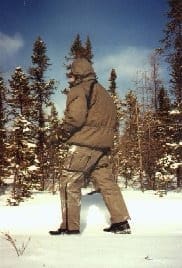
Today, when readers learn about BDS and its Charcoal colored Gore-Tex undergarment they are surprised that it wasn’t the outer most layer. One of the first military applications of Gore-Tex in the mid-80s was a lightweight 3-layer undergarment available commercially and known as a “Stealth Suit.” Although SOF units had had ECWCS for some time, this was still before camouflage hardshells were commonly available. Instead, this offered a lightweight waterproof breathable layer which could be stored in an ammo pouch. These commercial Gore-Tex undergarments were used by a variety of troops, becoming quite popular in Canada, and worn under their BDUs in order to maintain camouflage. The term stealth came about since shells at the time were quite noisy, making a “swish” sound while the stealth suit was worn under the combat uniform and was much quieter.
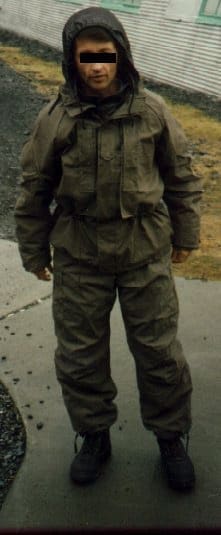
Some of the details of the system’s development are outlined in the book “The Commandos” by Douglas Waller in an interview with Sal Raineri. In my opinion Sal is the father of BDS and worked after retiring as a Green Beret at the Directorate of Combat Developments at the USAJFKSWCS, a tiny organization which eventually grew and grew into USASOC G8. Another alumnus of that shop is LTC Robert Harris (USA, Ret) who had served in the 9th Inf Div High Technology Test Bed and brought with him what became known as the Harris Assault Vest (Eagle Industires) as well as a bolo-style bayonet for the M16 that never went into production.
With its solid grey color the system was rejected, primarily due to institutional prejudice. At the time, everything was Woodland and OD. USASOC nominated BDS for the SEP program but the Infantry Center wasn’t interested. When LEP was finally adopted later in the decade, it was without the SOF BDU.


I swear maybe 12-13 years ago, LBT was offering their ultra low vis plate carrier in mouse grey. I think this was before wolf grey became a thing. Cool article, thanks.
LBT produces a lot of MAS grey, and may be what you remember. Mouse looks pretty close to some of the MAS I’ve seen, maybe closer to the Sepia color from Mustang , but you’d have to have them side by side to see how much they differ.
Interesting article – any designer that includes a boonie hat in the system is super cool, in my opinion.
What is not clear from the article is the “Gore-Tex undergarment?” T-shirt and boxer briefs or long sleeve top and pants? And how would this be worn? Next to the skin, or over the capilene but below any mid layers? Even though Gore-Tex is claimed to be breathable, I have often seen it as more of a vapor barrier.
Any clarity on these points would be appreciated.
Thanks for revisiting this concept. Interesting details as ever.
What’s the story with this nugget- “ bolo-style bayonet for the M16 ”?
LTC Harris showed it to me. It was wild, almost a khukri-style blade, without the forward sweep, so I’m going with bolo-style. Apparently somewhere made when he was with the 9th ID, but it never went anywhere. it was in 1990 so there weren’t cell phones and I didn’t take a camera to my visit with the team. Consequently, no photos, from me at least.
I remember Brigade Quartermasters selling a version of the goretex under suit.